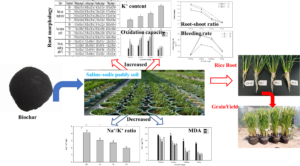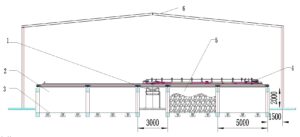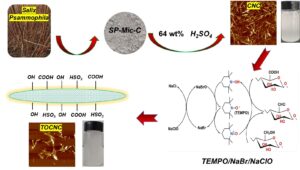Volume 17 Issue 1
Latest articles
- Researchpp 1241-1256Li, X., Yao, T., Huang, X., Li, X., Li, P., Du, S., Wang, W., Miao, S., Wang, D., Jin, F., and Shao, X. (2022). "Biochar increases rice yield by improving root morphological and root physiological functions in heavily saline-sodic paddy soil of Northeast China," BioResources 17(1), 1241-1256.AbstractArticlePDF

Saline-sodic soil is one of the major threats to crop growth, production, and quality. Biochar amendment could alleviate the adverse impacts of saline-sodic stress in crops. However, the effect of biochar on root morphological, root physiological functions, and rice yield in saline-sodic paddy soil has not been studied. Here, the underlying mechanisms of positive effects in morphological characteristics and physiological functions of rice roots under heavily saline-sodic paddy soil amended with biochar were evaluated. The soil was amended with biochar at zero-biochar (CK), 15g kg-1 soil (T1), 30 g kg-1 soil (T2), or 45 g kg-1 soil (T3). Biochar addition significantly increased root length, root volume, root dry weight, and root-shoot ratio at all growth stages. The root absorption vigor and root oxidization capacity were enhanced and increased significantly by decreasing Na+/K+ ratio, MDA content, and increasing K+ concentration in rice root after biochar amendment. The root bleeding rate of biochar treatments at different growth stage were 11.01% to 67.73% greater than these of CK. The yield of rice was increased significantly under saline-sodic paddy soil after biochar amendment. It was concluded that biochar had positive effect on the morphological characteristics and physiological functions in rice roots in saline-sodic paddy soil.
- Researchpp 1257-1269Liu, C., Zhang, R., Yu, J., Chang, J., and Zhang, W. (2022). "Comparative study of single stage and two-stage pretreatments on corn stover: A kinetic assessment," BioResources 17(1), 1257-1269.AbstractArticlePDF
The effects of two-stage pretreatment consisting of tepid water (first stage) and FeCl3 (second stage) pretreatments on hemicellulose hydrolysis were investigated. A kinetic comparison between the single stage (FeCl3-only pretreatment) and the two-stage pretreatment was evaluated. Compared with single stage pretreatment, the two-stage pretreatment decreased the activation energy Ea of hemicellulose hydrolysis by 38.3% and decreased the optimal reaction time by 34.8%. Besides, the xylose content increased by 14.9% and the catalyst dosage decreased by 31.9% in the two-stage pretreatment. This study provided an efficient pretreatment process for hemicellulose hydrolysis.
- Researchpp 1270-1284Xie, L., He, G., Wang, X., Tang, X., and Crocetti, R. (2022). "Hysteretic performance of angle steel connections in a timber-concrete composite system," BioResources 17(1), 1270-1284.AbstractArticlePDF
Timber–concrete composite systems are widely used in Europe, North America, and Australasia, primarily due to their good mechanical performance in terms of statics, dynamics, and seismic response. In addition, the concrete slab provides excellent protection to the timber, making such systems suitable for outdoor application. The seismic performance of timber–concrete composites is normally governed by their ductility and energy dissipation capacity. However, few design codes address the ductility and energy dissipation capacity of timber–concrete composite systems, owing to a lack of reliable performance data. Therefore, further research on the hysteretic performance of timber–concrete composite systems is necessary. In this study, six timber–concrete composite specimens with an angle steel connection of the same size were investigated using reversed cyclic tests. The corresponding failure modes were observed, and the salient features of the connection, i.e., the stiffness, ductility, and energy dissipation, were computed from the test results. The force mechanism of the timber–concrete composite specimens under reversed cyclic load was analyzed. Equations were presented to calculate the yield force and negative force in the same load step. A comparison of the test results and the theoretical results indicated good agreement.
- Researchpp 1285-1300Bailon-Salas, A. M., Ordaz-Diaz, L. A., and Domínguez-Calleros, P. A. (2022). "Agave durangensis vinasse as a biocide for forest pest control," BioResources, 17(1), 1285-1300.AbstractArticlePDF
In forestry practice, the prevention and fight against insect pests and diseases is a priority to preserve the health of these ecosystems. To combat it, insecticides of chemical and biological origin have been used. However, there are alternatives that have not yet been investigated, e.g., the use of agro-industrial waste. In the mezcal distillation process, polluting liquid residues called vinasses are generated, and these can be considered for pest control. In this project, the effect of vinasse from Agave durangensis subjected to different treatments was studied to evaluate its effect on forest phytopathogenic fungi. The mezcal vinasse was characterized physicochemically and by its metabolites. Furthermore, the percentage of inhibition in vitro of phytopathogenic (causing root wilt) fungi isolated from Pinus cooperi seedlings was studied. The fungi inhibition was related to the vinasse concentration. The lower pH and sterile raw vinasse showed a better inhibition effect. Four phytopathogenic strains of Pinus cooperi were isolated and identified, which corresponded to the genera Fusarium, Aspergillus, and Penicillium. None of the isolated were able to grow in potato dextrose-mezcal vinasse medium (PDMVM). Therefore, the mezcal vinasse showed fungicide activity in vitro against all strains.
- Researchpp 1301-1318Wu, Y., Shrestha, S., Guo, H., Zhang, J., Wang, H., and Qin, W. (2022). "Enhancement of saccharification of corn stover by cellulolytic enzyme produced from biomass-degrading bacteria," BioResources 17(1), 1301-1318.AbstractArticlePDF

Enzymatic saccharification of corn stover can be enhanced by partially replacing commercial enzymes with bacterial crude enzyme extracts. Thus, in this study, three bacteria (Bacillus sp. A0, Bacillus sp. CH20S1, and Exiguobacterium sp. AS2B) were cultured in a media with corn stover as the substrate to produce crude enzyme extract and saccharify corn stover. The cultural conditions were monitored and optimized to maximize CMCase and xylanase activity in the crude enzyme extracts. After 72 h of hydrolysis of corn stover with diluted crude enzymes (DCE) from the three strains, reducing sugars ranging from 48.2 to 71.7 mg g-1 were released from non-pretreated and pretreated corn stover. Furthermore, the maximum reducing sugars of 316 and 321 mg g-1 were observed when 12 and 4 FPU g-1 of commercial cellulase were added to the DCE of the CH20S1 strain, respectively. It was shown that an effective combination of bacterial DCE with commercial enzymes could achieve higher saccharification of lignocellulosic biomass, which might be cost-efficient compared to their single-use. Overall, this study aims to show the enhanced enzymatic saccharification of corn stover.
- Researchpp 1319-1337Bai, J., Li, Y., Jiang, S., and Guan, H. (2022). "Preparation of wood furniture cooling coatings based on phase change microcapsules and its performance study," BioResources 17(1), 1319-1337.AbstractArticlePDF
Due to the small thermal conductivity of wooden furniture, there is a better cooling effect in the initial contact with the human body during the summer. However, after long-term contact, heat cannot be exported, resulting in heat accumulation, which affects the thermal comfort. Phase change microcapsules (PCM) can be added to water-based coatings for wood furniture to achieve a lower contact temperature by using the heat absorption properties of its phase change process. Thus, it improves the thermal comfort of the human body for long-term use. In this study, the PCM were added to a water-based paint for wooden furniture. By testing the microscopic properties and thermal properties, it was found that the PCM powder could undergo phase change and absorb heat after dispersing in water-based paint. Secondly, fiberboard coated with different solid content of microencapsulated coatings was tested by homemade equipment at 27 °C room temperature. The results showed that the addition of PCM can significantly change the contact temperature. And as the amount of microcapsules added increased, the cooling effect was more obvious. At the same time, the addition of microcapsules can cause matting of the paint film and have an effect on the hardness of the paint film. Therefore, the cooling effect can be achieved by stacking the paint film or controlling the amount of microcapsules.
- Researchpp 1338-1353Qu, H., Cao, J., Wang, P., Li, R., Qi, Z., Fu, J., Chen, Y., and Chen, M. (2022). "Volatile organic compounds and dominant bacterial community during aerobic composting of vegetable waste and cow manure co-complexing," BioResources 17(1), 1338-1353.AbstractArticlePDF

Vegetable waste was aerobically composed using a trough-type system, and the resulting emitted volatile organic compounds were investigated. In addition, the succession pattern of microorganisms was analyzed. Aerobic fermentation was conducted using a tomato stalk-cow dung mix (a water content of 65% and a carbon-to-nitrogen ratio of 25:1). The emitted volatile organic compounds comprised of 58 kinds of compounds, including 2 sulfur-containing compounds, 3 alcohols, 3 esters, 3 aldehydes, 3 ketones, 6 halogenated hydrocarbons, 18 aromatic hydrocarbons, 17 alkanes, and 3 alkenes. The primary volatile organic compounds produced were methyl sulfide, ethyl acetate, ethanol, and acetaldehyde. Clustering and principal coordinate analysis suggested that the community succession changed throughout the composting process in the odor-producing habitat. High-throughput sequencing revealed that the bacterial community was comprised of Firmicutes, Chloroflexi, Proteobacteria, and Actinobacteria, whereas the dominant flora included Ascomycota, Basidiomycota, and Mucoromycota. These findings could aid in the mitigation of volatile organic compounds and odors during vegetable waste composting as well as contribute to the development of deodorizing bacteria.
- Researchpp 1354-1363Snow, R. D., Shmulsky, R., Bobadilha, G., and Lopes, D. V. (2022). "Bending strength and stiffness of three-ply bolt-laminated mixed oak and hardwood industrial mats," BioResources 17(1), 1354-1363.AbstractArticlePDF
Crane mats provide safe, stable, and flat work surfaces for heavy equipment and provide environmental protection. In this manuscript, two types of three-ply mats from two geographic regions were evaluated for stiffness and strength. Mats were sourced from the Southern USA and Midwestern USA in both solid configurations where the boards in all plies are touching and waffle configurations where gaps of approximately 1.8 inches were left between boards. Both types were mechanically fastened with regularly scheduled 3/8th inch diameter carriage bolts. The mats consisted of 1.5-inch-thick mixed oak and hardwood lumber oriented in a similar manner to plywood to form 4.5-inch-thick panels, each of which is 8 ft x 14 ft. Mats were prepped for testing by being ripped into strips 24 ± 4 inches wide. In this manner, 28 test specimens were developed from 7 parent mats. Mats were subjected to three-point bending tests. In both types of mats, the Southern-sourced specimens were statistically stronger and stiffer than those from the Midwest. Modulus of rupture (MOR) results showed that solid mats from the South were stiffer compared to waffle configurations produced in either location. The regression analysis indicated that modulus of elasticity could potentially estimate MOR.
- Researchpp 1364-1372Kim, M., Chang, Y., Kang, J., Lee, J., and Eom, C. (2022). "Presence of tyloses in 6 Korean oak species for production of liquor barrels and correlation of retention of large vessel lumen," BioResources 17(1), 1364-1372.AbstractArticlePDF
This study was conducted to devise ways of promoting the use of deciduous trees that have increased in number with climate change. For six oak species commonly utilized to produce liquor barrels, normal wood and tension wood were classified by part. Then, both large vessel lumen area and tyloses were quantitatively assessed. The findings showed that in both normal and tension woods, large vessel lumen area was largest in sapwood, followed by heartwood and juvenile wood. Tyloses were found in both normal and tension woods of all the six species, but the number of tyloses varied according to species. It was heart wood that contained the highest amount in both normal and tension woods. It was also revealed that the number of tyloses decreased with the growing area of large vessel lumen. This study will provide fundamental data to decide oak tree species for the production of liquor barrels.
- Researchpp 1373-1384Zhong, Y., Gao, X., Zhang, W., Wang, X., and Wang, K. (2022). "Carboxylated nanocrystalline cellulose from Salix psammophila prepared by sulfuric acid hydrolysis combined with 2,2,6,6-tetramethylpiperidine-1-oxyl (TEMPO)-oxidation," BioResources 17(1), 1373-1384.AbstractArticlePDF

Salix psammophila (SP) is an important sand plant, and could be utilized to develop high-value products. In this work, SP was used as raw material and cellulose nanocrystals (CNC) were prepared by hydrolysis in 64 wt% sulfuric acid (H2SO4) solution, and then, TEMPO/NaBr/NaClO system was used to oxidize CNC to obtain TEMPO-oxidation-cellulose nanocrystals (TOCNC). Fourier transform infrared analysis (FTIR) revealed that after oxidation, there were obvious carboxyl functional groups. Scanning electron microscopy (SEM) showed that both CNC and TOCNC were agglomerated. Under atomic force microscope (AFM) and transmission electron microscopy (TEM), CNC and TOCNC presented short rod fibers, average diameters of 23 nm and 21 nm and average lengths of 213 nm and 165 nm, respectively. X-ray photoelectron spectroscopy analysis (XPS) showed that TOCNC generated a new energy spectrum peak at 289.06 eV, which was the peak of C=O in the carboxyl group. The crystallinity of the CNC and TOCNC were 70.8% and 26.9%, respectively.
